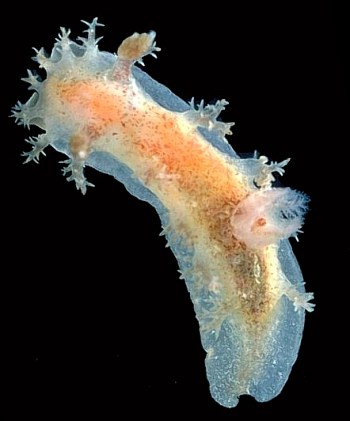
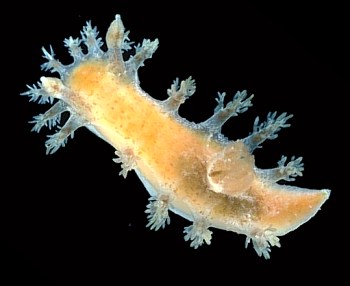
Kaloplocamus ramosus
(Cantraine, 1835)
Order: NUDIBRANCHIA
Suborder: DORIDINA
Superfamily: ANADORIDOIDEA
Family: Polyceridae
Subfamily: Triophinae
DISTRIBUTION
First described from the Mediterranean. has since been reported from South Africa, West Africa, Japan and eastern Australia.
PHOTO
Coffs Harbour Region, northern New South Wales, December 1990. PHOTOS: Bill Rudman.
Polycerid, growing to about 30mm, with brown or reddish spots all over body and a row of large papillae around the mantle edge. The upper half of the papillae have many retractile unbranched secondary papillae. This species has been found feeding on encrusting bryozoan colonies. The apparent worldwide distribution suggests that this species has been artificially transported around the world in association with fouling bryozoans.
Reference:
• Cantraine, F.J. (1835). Mollusques - 'diagnoses ou descriptions succinctes de quelques espèces nouvelles de mollusques. Bulletin de l'Académie Royale des Sciences et Belle-lettres de Bruxelles, 2: 380-401
• Valles, Y., Valdes, A. & Ortea, J. (2000) On the phanerobranch dorids of Angola (Mollusca, Nudibranchia): a crossroads of temperate and tropical species. Zoosystema, 22(1): 15-31.
Rudman, W.B., 1999 (October 30) Kaloplocamus ramosus (Cantraine, 1835). [In] Sea Slug Forum. Australian Museum, Sydney. Available from http://www.seaslugforum.net/find/kaloramo
Related messages
Kaloplocamus ramosus ? : new for the Bay of Biscay
April 1, 2010
From: Alex Vanhaelen
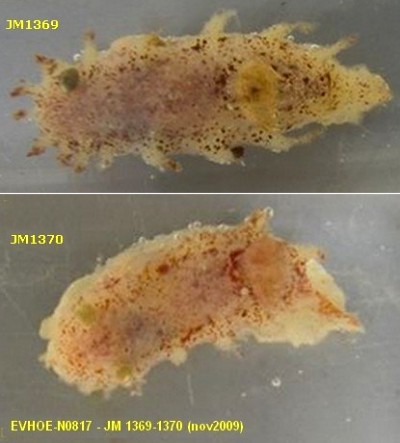
Dear Dr Rudman,
Hear are some pictures of opisthobranchs collected between 21 October and 12 November 2009 by bottom-trawling in the northern part of the Bay of Biscay (NE-Atlantic, off the French coast) at depths ranging from 133 to 185 meters, offshore the southern Brittany peninsula, along a gross line extending from 45°37'20 N - 3°13'41,70 W to 47°04'13,94 N - 5°11'23,71 W. (EVHOE 2009 cruises).
I have received preserved specimens (in ethanol) and some pictures taken in-vitro of living specimens from one of the on-board biologists (Mrs J. Martin, from IFREMER) and I try to identify them for her.
The joined pictures are :
1) N0817 JM1396-1370 2 living specimens; submerged
2) N0796 PL1247-1249 4 living specimens in the dry
3) N0822 VA-833 preserved; back side + scale
4) N0822 VA-836-837-839 preserved; anterior process, rhinophore, branchial plume
5) N0822 VA-840-842-844 preserved; right side, left side, ventral side
I am not familiar with deep-sea species but, with the help of theseaslugforum, I think it might be Kaloplocamus ramosus (Cantraine, 1835). I would certainly welcome your opinion on this identification, since, if I am correct, this would be, to my knowledge, the first reports of this species for the French Atlantic coast.
Locality: Northern part of the Bay of Biscay, offshore the southern Brittany peninsula, , ranging from 133 to 185 meters, France, NE-Atlantic, Between 21 october and 12 november 2009 , bottom trawling. Length: 20 to 26 mm.. Photographer: several.
In the forum messages #1478 and #13091, you mentioned your interest in examining NE-Atlantic specimens. If you are still interested, I have received the authorization from the collector (Mrs J. Martin) to send you a couple at the adress of your choice.
I thank you very much for your help in this particular case and also for the immense help the forum provides to all interested in Opisthobranchia.
Sincerely yours,
Alex Vanhaelen
Scientific associate (Malacology section) of
the Royal Belgian Insitute for Natural Sciences (RBINS)
Belgium
a_vanhaelen@hotmail.com
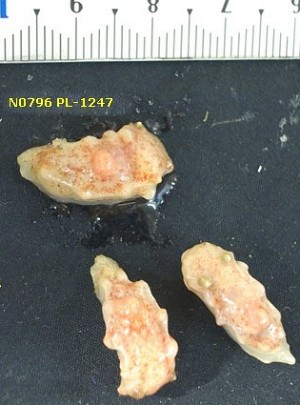
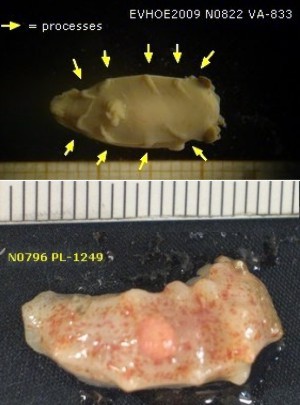
Dear Alex,
I suspect this is K. ramosus. Apart from the Mediterranean records, there are Atlantic records from Angola (Valles et al, 2000) and the Azores (Valles et al, 2006). Looking at the recent Checklist of Iberian opisthobranchs (Cervera, et al, 2006) This species does not seem to have been reported from the Atlantic coast of Spain and Portugal so this find from the Bay of Biscay does appear to extend its distribution quite a bit. Of course its anatomy would have to be looked at to be sure. Thanks for the offer of sending specimens, but I think it would be better if you let us know in what institution the specimens are stored so that either I or some other researcher can ask to borrow them when are working on the group.
- Cervera, J. L., G. Calado, C. Gavaia, M. A. E. Malaquias, J. Templado, M. Ballesteros, J. C. Garcia-Gomez, & C. Megina. 2006. An annotated and updated checklist of the opisthobranchs (Mollusca: Gastropoda) from Spain and Portugal (including islands and archipelagos). Boletin Instituto Espanol de Oceanografia 20(1-4):1-122.
- Valles, Y., Valdes, A. & Ortea, J. (2000) On the phanerobranch dorids of Angola (Mollusca, Nudibranchia): a crossroads of temperate and tropical species. Zoosystema, 22(1): 15-31.
- Valles, Y. & Gosliner, T. (2006). Shedding Light onto the Genera (Mollusca: Nudibranchia) Kaloplocamus and Plocamopherus with Description of New Species Belonging to These Unique Bioluminescent Dorids. The Veliger 48(3): 178-205.
Best wishes,
Bill Rudman
Kaloplocamus ramosus from the Yellow Sea
August 18, 2006
From: Dong Bum Koh
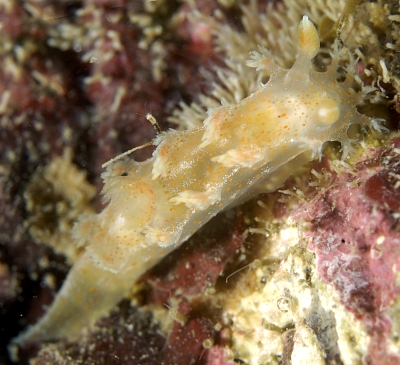
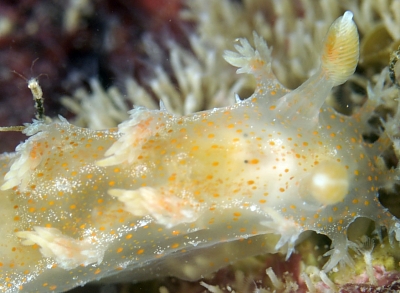
Dear Bill,
Last weekend our DEPC (Digital Eco-Photo Club) members were toured in Yellow Sea.
We've got several photos from Tae An area.[126° E 36° 8'N] including this photo of Kaloplocamus ramosus.
Locality: Tae An area.[126° E 36° 8'N], -10m, South Korea, Yellow Sea, 5~6 August 2006, --. Length: --. Photographer: Sung Soon Choi.
Best regards,
Dong Bum Koh
drkoh@seasee.co.kr
Koh, D.B., 2006 (Aug 18) Kaloplocamus ramosus from the Yellow Sea. [Message in] Sea Slug Forum. Australian Museum, Sydney. Available from http://www.seaslugforum.net/find/17433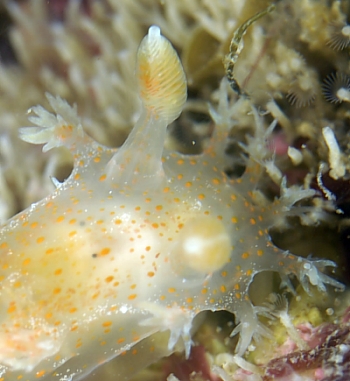
Dear Koh,
As I discuss elsewhere on the Forum, this species was first described from the Mediterranean so it is good to get more photos from the NW Pacific for comparison.
Best wishes,
Bill Rudman
Kaloplocamus ramosus from Bare Island, Sydney
December 17, 2005
From: Nicholas Missenden
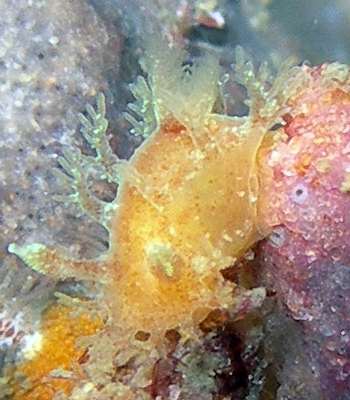
Hi Bill,
Hope you can help me with the id of this nudibranch that I recently saw whilst night diving at Bare Island.
Locality: Bare Island, South Wall. NSW, Botany Bay, Australia. Depth: 17 m. Length: 12 mm. 04 December 2005. Broken reef, sandy bottom
Photographer: Nicholas Missenden
Kindest regards.
Nick
njmpm@iinet.net.au
Missenden, N.J., 2005 (Dec 17) Kaloplocamus ramosus from Bare Island, Sydney. [Message in] Sea Slug Forum. Australian Museum, Sydney. Available from http://www.seaslugforum.net/find/15422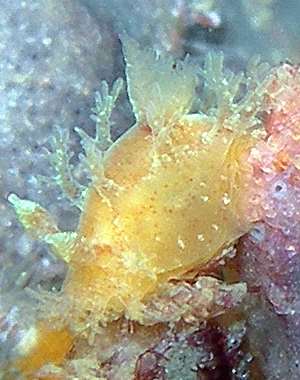
Dear Nick,
This is what we identify here as Kaloplocamus ramosus. If our identification of this animal is correct, it also occurs in the Mediterranean, which suggests that it has either been artificially introduced to Australia or the Mediterranean.
Best wishes,
Bill Rudman
Kaloplocamus sp? from New South Wales
December 17, 2005
From: Leander Wiseman
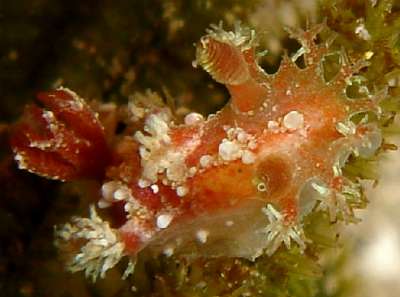
Hi Bill,
Can you please ID this nudi.
Found on a night dive at Summercloud Bay, NSW Australia. It was about 15 mm long. It seems similar to Kaloplocamus ramosus, though more "warty".
Locality: Summercloud Bay, NSW, Australia. Depth: 10 m. Length: 15 mm. 03 August 2005. On algae, scattered rocky reef. Photographer: Leander Wiseman
Cheers
Leander
leanderwiseman@yahoo.com
Wiseman, L.M., 2005 (Dec 17) Kaloplocamus sp? from New South Wales. [Message in] Sea Slug Forum. Australian Museum, Sydney. Available from http://www.seaslugforum.net/find/15478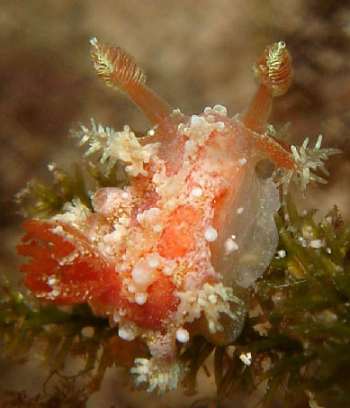
Dear Leander,
I am pretty sure this is part of the variation found in this species, although the white warty tubercles are strange.
Best wishes,
Bill Rudman
Kaloplocamus ramosus? from Hawaii
February 11, 2005
From: Scott Johnson
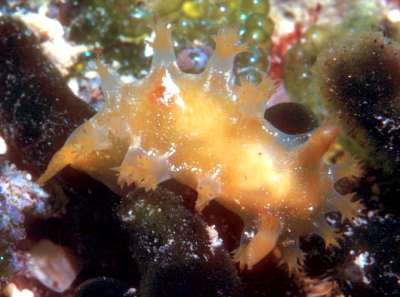
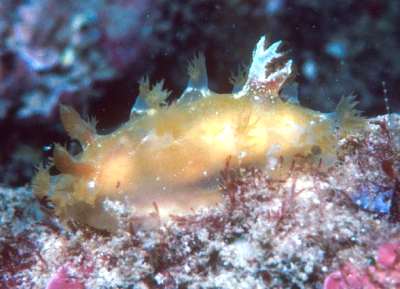
Hi Bill,
Do these look like they could be Kaloplocamus acutus? These Hawaiian specimens are much lighter in coloration than the other photos on the Forum. The species is relatively rare in Hawaii. I found about 10 individuals over several years in the late 70s and mid 80s, all in ledges and small caves at night at depths of about 5 to 10 meters. One of the photos shows one feeding on a bryozoan.
Locality: Oahu (Makua) and Hawaii (Puako). Hawaii, USA. Depth: 5-10 meters. Length: 20-25 mm. Ledges at night. [lower photo 27 April 1985 (h106-3)].Photographer: Scott Johnson
Scott
uwkwaj@yahoo.com
Johnson, S., 2005 (Feb 11) Kaloplocamus ramosus? from Hawaii. [Message in] Sea Slug Forum. Australian Museum, Sydney. Available from http://www.seaslugforum.net/find/13091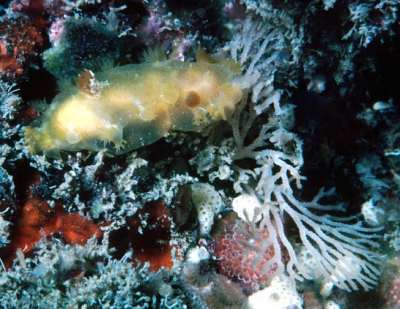
Dear Scott,
I am pretty sure this is Kaloplocamus ramosus. The compound papillae are more robust and have many more branches than in K. acutus and K. ramosus never has the typical white and orange coloration. As I have discussed in other messages, some anatomical information to compare with the Atlantic-Mediterranean populations would be useful
Best wishes,
Bill Rudman
Kaloplocamus ramosus from Korea
June 15, 2002
From: Dong Bum Koh
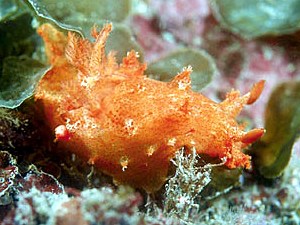
Dear Bill.
Here is a photo Kaloplocamus ramosus from Korea for the Forum.
Data: Mun islet southeast of Cheju Island, southern Korea. Photo: Dong Bum Koh
With Best Regards.
Dr Dong Bum, Koh
http://www.seasee.co.kr/2000default01.asp
drkoh@seasee.co.kr
Koh, D.B., 2002 (Jun 15) Kaloplocamus ramosus from Korea. [Message in] Sea Slug Forum. Australian Museum, Sydney. Available from http://www.seaslugforum.net/find/7189Thanks Dr Koh,
Welcome to the Forum. Photos from southern Korea will be an interesting addition to the Forum. Yes this is the animal we are calling K. ramosus. The only problem being that that species was initially described from the Mediterranean. This 'species' is either a complex of similarly shaped species or else it has been distributed worldwide artificially.
Best wishes,
Bill Rudman
Kaloplocamus from New Zealand
March 6, 2002
From: Gareth Jones
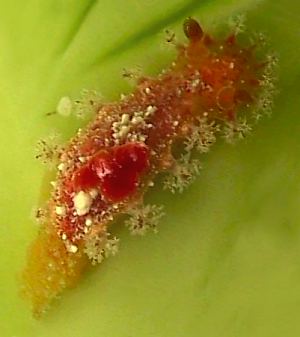
Hi.
I Found this one on at the Poor Knights as usual. I have seen Tritonia incerta on the adjacent coast but never at the Poor Knights Ids [northeastern New Zealand]. This looks very different to me. Any ideas?
Cheers
Gareth Jones
Pacific Hideaway, NZ
rees@divenz.co.nz
Jones, G., 2002 (Mar 6) Kaloplocamus from New Zealand. [Message in] Sea Slug Forum. Australian Museum, Sydney. Available from http://www.seaslugforum.net/find/6327Dear Gareth,
This is another intersting find and new record from New Zealand. It is an animal we are calling Kaloplocamus ramosus. It is found in southeastern Australia and similar animals are reported in the Forum from Hong Kong. True K. ramosus is from the Mediterranean, so if this Pacific animal is the same, it probably got here as a hitchhiker on the bottom of a boat. It feeds on encrusting bryozoans which could easily foul a ship's hull and provide a home, and food, for a fellow traveller.
Best wishes,
Bill Rudman
Kaloplocamus cf. ramosus from Hong Kong
February 5, 2002
From: Bill Rudman & Brian Darvell
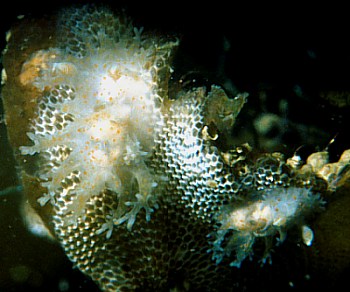
Here is some information and photos on Kaloplocamus cf. ramosus from Brian Darvell's Hong Kong collections.
Similar to Kaloplocamus acutus in shape but body is translucent white with some brownish shading and many reddish brown or reddish orange spots. There are some white specks and small white papillae on the sides of the body. This colour form is illustrated from Japan (Baba 1949, pl. 13, fig. 47). Another colour form illustrated by Baba (pl. 13, fig. 46) is of a vivid orange body with minute spots of chocolate on the back and sides. Most authors identify the Japanese species with K. ramosus from the Mediterranean. Unfortunately there is considerable difference in radular morphology between K. ramosus as described by Schmekel and Portmann and K. croceus described by Vayssiere, 1901. Until more is known of material from the Mediterranean the correct identity of these specimens from the NW Pacific will be difficult to determine. Another uncertainty is the relationship of these species to a very similar species or pair of species from southeastern Australia, which seem to have a similar range of colour to that illustrated by Baba (1949) from Japan. The Australian specimens, or at least those with an orange background colour, can be identified with Kaloplocamus yatesi (Angas 1864). If the Mediterranean and Indo-West Pacific species prove to be a single species then the name K. ramosus would clearly take precedence but if not then careful consideration would have to be given to the relationship between the Japanese and Australian species for K. yatesi is clearly the oldest name for an Indo-West Pacific species. This species, which can grow to 4 cm in length, feeds on encrusting bryozoans. The largest Hong Kong specimen has a preserved length of 20 mm.
PHOTO:
UPPER RIGHT: AM C141492, 13 specimens, 25 February 1984, Site 10.99, Kiu Tau (W), Kiu Tsui Chau, Port Shelter, 4-7 m. LOWER LEFT: AM C141493, 24 February 1984, Site 14.41, Tai Tam Harbour, Hong Kong Is., 0.5 m. LOWER RIGHT: AM C 139130, 11 specimens, 11 April 1983, Site 4.59, Gau Tau (N), Mirs Bay, 5-12 m. PHOTOS: Brian Darvell.
Hong Kong Collection Records:
AM C 139130, 11 specimens, 11 April 1983, Site 4.59, Gau Tau (N), Mirs Bay, 5-12 m. AM C139131, 11 April 1983, Site 4.60, Kong Chau (NW), Mirs Bay, 5-10 m. AM C139132, 13 April 1983, Site 4.65, Chek Chau (NE), Mirs Bay, 2-6 m. AM C139133, 4 specimens, 14 April 1983, Site 2.32, Round Is. (E), Mirs Bay, 3-10 m. AM C139134, 2 specimens, 14 April 1983, Site 2.66, Round Is. (W), Mirs Bay, 3-6 m. AM C139135, 2 specimens, 15 April 1983, Site 2.67, Kai Kung Tau, Kat 0 Chau, Mirs Bay, 5-10 m. AM C139136, 19 April 1983, Site 4.8, Breaker Reef, Mirs Bay, 5-16 m. AM C 141482, 22 January 1984, Site 13.96, Shum Wan (W), Lamma Is., 6 m. AM C141492, 13 specimens, 25 February 1984, Site 10.99, Kiu Tau (W), Kiu Tsui Chau, Port Shelter, 4-7 m. AM C141493, 24 February 1984, Site 14.41, Tai Tam Harbour, Hong Kong Is., 0.5 m. AM C142183, 31 March 1984, Site 10.99, Kiu Tau (W), Kiu Tsui Chan, Port Shelter, 4 m. AM C150283, 5 April 1986, Site 5.128, Heung Lo Po (E), Tolo Channel, 2 m. Depth range: 0.5-16 m.
Reference:
• Rudman, W.B. & Darvell, B.W. (1990) Opisthobranch molluscs of Hong Kong. Part 1. Goniodorididae, Onchidorididae, Triophidae, Gymnodorididae, Chromodorididae, (Nudibranchia). Asian Marine Biology, 7: 31-79
Best wishes,
Bill Rudman & Brian Darvell
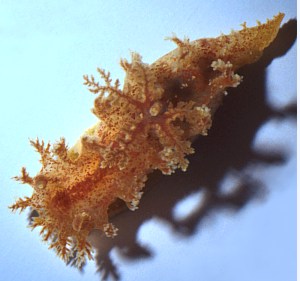
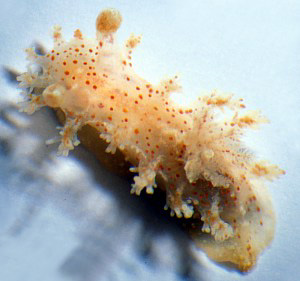
Kaloplocamus ramosus in Port Hacking, NSW
March 7, 2000
From: Erik Schloegl
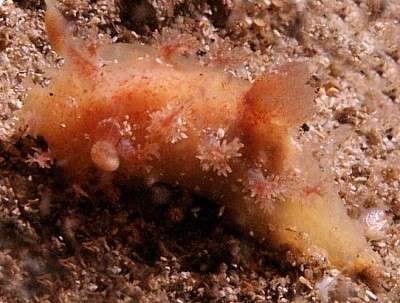
Dear Bill,
As in my last message on Polycera capensis, here's another species that I think might have been artificially introduced to Australia - if my tentative identification of this animal as Tritonia nilsodhneri is correct. The photo was taken on October 18, 1998, at Ship Rock Aquatic Reserve in Port Hacking, New South Wales, Australia. I've dived the site quite often since then, but haven't seen this species again. The depth was 15m, on sandy bottom.
Best regards,
Erik Schloegl
schloegl@maths.uts.edu.au
Schloegl, E., 2000 (Mar 7) Kaloplocamus ramosus in Port Hacking, NSW. [Message in] Sea Slug Forum. Australian Museum, Sydney. Available from http://www.seaslugforum.net/find/2028Dear Erik,
This is Kaloplocamus ramosus. Even though your id is wrong
it is possible you are correct in thinking it is an immigrant. If our identification of this animal is correct, it also occurs in the Mediterranean. This suggests that it has either been artificially introduced to Australia or the Mediterranean.
About its erratic appearance. Quite a few of these bryozoan feeders have unpredictable appearances, sometimes very common, other times absent. It is possible that many of them are 'injected' into particular sites by shipping, but it is also possible that their food bryozoan is also an irregular visitor, and without its presence the nudibranch larvae won't settle out of the plankton.
Best wishes,
Bill Rudman.
Kaloplocamus ramosus from Malta
November 3, 1999
From: Constantine Mifsud
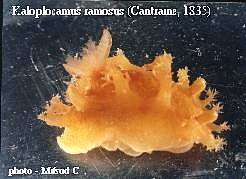
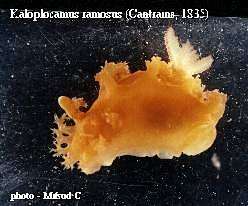
Seeing Grey McNeil's message on Kaloplocamus ramosus from Australia, I am posting a couple of photos of a specimen of Kaloplocamus ramosus which I have recently dredged from 60-80m in a sand-maerl substrate off western Malta, in the Mediterranean. Is it possible that this species has such a wide distribution?
Constantine Mifsud
kejdon@orbit.net.mt
Mifsud, C., 1999 (Nov 3) Kaloplocamus ramosus from Malta. [Message in] Sea Slug Forum. Australian Museum, Sydney. Available from http://www.seaslugforum.net/find/1478Dear Constantine,
It is unlikely that Kaloplocamus would have such a natural distribution, but as it feeds on fouling bryozoans, it could have been assisted in its travels by ship traffic, much as other polycerids such as Thecacera pennigera and Polycera hedgpethi, seem to have done.
From published drawings, Mediterranean specimens have a very similar radular morphology to animals from Australia, but if you could send me a few specimens I would very much like to take Scanning Electron Microscope photos to post on the Forum and compare with ones I have of Australian animals.
Best wishes,
Bill Rudman.
Kaloplocamus ramosus? from Australia
October 31, 1999
From: Grey McNeil
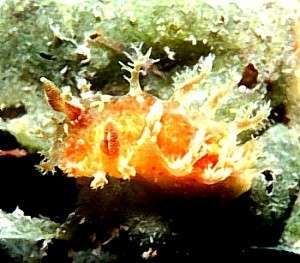
Dear Bill,
Could you identify this photo please. The details are:
PIPELINE, NELSON BAY, Port Stephens, New South Wales, eastern Australia, 7m, June 1999, 2cm long.
Thanks,
Grey McNeil.
GREYMACIND@bigpond.com.au
Dear Grey,
This animal is related to Plocamopherus. It has been identified as Kaloplocamus ramosus which was originally described from the Mediterranean.
Bill Rudman.
Rudman, W.B., 1999 (Oct 31). Comment on Kaloplocamus ramosus? from Australia by Grey McNeil. [Message in] Sea Slug Forum. Australian Museum, Sydney. Available from http://www.seaslugforum.net/find/1005